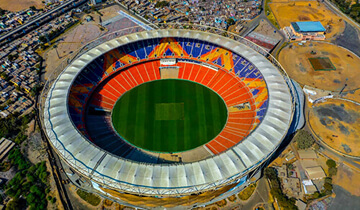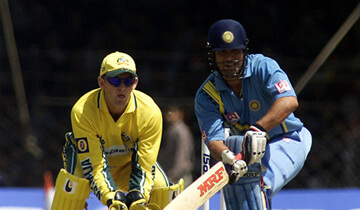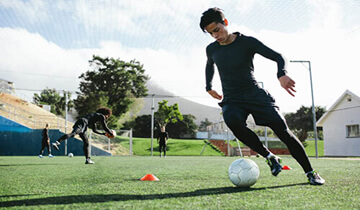Why do male soccer players wear sports bras?
Male soccer players are often seen wearing tight-fitting vests that resemble sports bras during practices and games. This vest-like garment has sparked curiosity among fans who wonder why players wear something that looks like a bra.
Purpose of the Compression Vest
The vest that male soccer players wear is actually a compression garment, not a bra. It serves several purposes:
Provides Muscle Support
The tight fit of the compression vest helps keep muscles stabilized and supported during the intense sprinting and cutting movements required in soccer. The compression can help reduce muscle vibration and fatigue.
Prevents Injuries
The extra support and stabilization from the vest may help prevent muscle strains and other injuries common in soccer like groin pulls or hamstring tears.
Improves Circulation
Compression garments are thought to improve circulation by increasing blood flow to muscles. Better circulation can aid recovery and clear metabolic byproducts like lactic acid.
Enhances Proprioception
The snug fit of the vest is believed to enhance proprioception by allowing players to better sense and control movements of their limbs. This can improve coordination, balance, and agility.
Provides Comfort
The thin, stretchy, and breathable fabric makes the vests cooler and more comfortable to wear than a normal shirt under the hot lights of a soccer stadium.
While it may look like a sports bra, the compression vest worn by male soccer players provides important performance and recovery benefits. The tight-fitting garment supports muscles, prevents injury, improves circulation, enhances movement control, and adds comfort as players battle it out on the pitch.
What is the Vest Soccer Players Wear?
It is not actually a bra, but a GPS tracking vest designed to monitor player performance.
The vest that soccer players wear during training and matches may look like a sports bra or compression top to the casual observer. However, its purpose goes far beyond simply providing support. It is actually an advanced piece of wearable technology used to track a wide range of performance metrics.
The vest contains a pocket on the back that holds a small GPS tracking pod, usually about the size of an adult hand.
The pod contains sensors such as accelerometers, gyroscopes, and GPS antennae to monitor things like speed, distance covered, acceleration/deceleration rates, heart rate, and more. The data is transmitted wirelessly to computers on the sidelines where coaches and analysts can access real-time information on each player.
The pod fits into a pocket on the back of the vest situated right between the shoulder blades. This location allows the sensors to capture body movements and vitals accurately. The pod is usually secured with velcro or a zipper to prevent it from dislodging during intense physical activity.
It is designed to be tight-fitting so the pod stays in close contact with the body to collect accurate data.
The vest is made from lightweight, breathable fabrics like lycra spandex and contains some compression technology. The tight fit ensures the GPS pod maintains full contact with the athlete’s body to record precise measurements.
If the vest was loose fitting, the pod might bounce around and not pick up the nuances of an athlete’s movements. A tight, second-skin fit keeps everything locked in place. The vest is tailored to put no restrictions on motion or flexibility so players can move completely unhindered.
Advanced data analytics has become integral to soccer at the elite level. The GPS tracking vest provides coaches and staff a detailed technical breakdown of each player’s physical performance. This allows them to design optimized training programs, better manage player workloads, and make informed decisions based on data-driven insight.
Why Do Players Wear the GPS Vest?
To track performance stats
Players wear GPS vests during training and matches to track a range of performance statistics like distance covered, top speed, acceleration/deceleration, and heart rate. The vests contain a small GPS module along with other motion sensors that provide detailed data on the player’s physical outputs. This data is transmitted wirelessly to a computer or tablet on the sidelines where coaching staff can monitor the information in real-time.
Some of the key stats measured by the GPS vests include:
- Total distance covered - e.g. how much ground a player covers during a match
- Top speed - the maximum speed a player reaches during a sprint
- Number of high speed runs - how often a player accelerates close to their top speed
- Acceleration/deceleration - how quickly a player can speed up or slow down
- Heart rate - measured via a heart rate monitor strapped to the player’s chest
Coaching staff use data to monitor workload, prevent injury, assess fitness
The GPS data from the vests allows coaches and sports scientists to closely monitor each player’s workload during training and matches. This helps them manage the player’s physical stress and fitness levels effectively.
Some of the key ways coaching staff utilize the GPS data:
- Monitor total workload over a week to balance training load and avoid overtraining risk
- Identify spikes in workload from intense sessions to adjust training accordingly
- Assess running volumes, high speed efforts etc. and adapt programs for return from injury
- Gauge fatigue levels based on outputs like distance covered and compare to baselines
- Inform substitution decisions - e.g. replace players whose stats indicate high exertion
The data helps minimize injury risk by preventing coaches from overtraining players. It also aids in effective injury rehabilitation by tracking progress back to match fitness.
Provides objective data to guide coaching decisions
The GPS vest data provides objective, measurable insights into each player’s performance and workload - data that is far more detailed than traditional statistics or subjective coaches’ observations.
This data allows coaches to make more informed, evidence-based decisions about:
- Individual training programs tailored to players’ strengths and weaknesses
- Appropriate training loads at different stages of season to optimize fitness
- Squad rotation and substitutions during congested fixtures based on fatigue indicators
- Return to play timeframes after injury absence based on match-readiness metrics
Rather than “guesswork”, coaches can rely on hard data from the GPS vests to guide their decisions.
Allows detailed analysis of performance over time
The GPS vest data is stored and can be analyzed over longer periods to identify trends and patterns.
Looking at the data over weeks or months allows coaches to:
- Assess improvements in fitness - e.g. increases in distance covered or high intensity runs
- Identify weaknesses to focus training on - e.g. low top speeds compared to position averages
- Review performances in different positional roles and formations
- Compare match data versus training loads and intensities
- Inform recruitment decisions by profiling potential signings
This longer term analysis uncovers insights that complement the real-time monitoring and helps tailor training programs.
In summary, the GPS player tracking vests provide detailed data on physical performance that allows coaches to train players effectively, reduce injury risk, make informed decisions, and analyze progress over time. The technology has become an indispensable tool for professional teams.
Do Players Wear the Vest During Games?
Players wear the vest mostly in practices, but may wear it during games as well.
Professional and college athletes often wear tracking vests or other wearable technology during practices to collect biometric data to analyze performance. The vests contain sensors that can track things like heart rate, breathing rate, speed, acceleration, and more.
Coaches and trainers use this data to monitor player exertion levels, workloads, and intensity during drills and scrimmages. It helps them determine if players are being overworked or undertrained. The data also identifies strengths and weaknesses in an athlete’s conditioning.
While practices are the most common time for players to wear the vests, they may also wear them during actual games. However, this is less frequent for a few reasons:
- The data is not usually monitored in real-time during games. It is compiled after the fact for analysis. So wearing the vest during games is not always necessary.
- There are restrictions on what can be worn during official games based on sport leagues’ uniform rules. The tracking vest may not be allowed or may need to be worn under the jersey.
- Some players find the vest uncomfortable or restrictive during games when performance matters most. They may not want to wear extra equipment that could impact their play.
However, coaches may request certain players wear the tracking vest during games in important situations, such as:
- Monitoring a starter who is returning from injury to see how hard he is exerting himself during game action.
- Tracking a key bench player’s exertion when subbed into the game cold.
- Analyzing a struggling player’s physiological data to look for fatigue, low effort, or other issues affecting performance.
So while practices are the standard time for biometric tracking, teams may also have players wear the vest during games periodically when the need for data arises. But it is usually focused on certain players in specific situations, not the entire team for every game. The data helps provide an objective assessment of their physical performance during competition.
Coaches may request certain players wear a vest during a game to track performance if needed.
While most biometric tracking takes place during practices, coaches may ask select athletes to wear their GPS-enabled vest during certain games. This targeted tracking during competitions allows coaches to gather key performance data on players in critical game situations.
Reasons a coach may request game-time tracking include:
- A star player is returning from injury - the vest allows trainers to monitor exertion level, acceleration, deceleration, and other metrics to assess their physical readiness.
- An underperforming player suddenly starts - the vest data provides insights into their effort, fatigue, and conditioning compared to practice levels.
- A struggling freshman gets significant minutes - the biometric analysis identifies strengths/weaknesses to help determine if they are a fit for the system.
- The team is playing a major rival game - vests provide across-the-board data to compare starters vs. backups and analyze performance under pressure.
The vest data does not get monitored in real-time during the game. Rather, it gets downloaded and analyzed after the fact to extract meaningful insights. Coaches use it to make adjustments to training, substitution patterns, and game plans based on the objective data collected on player exertion and stamina during intense game action.
Targeted biometric tracking provides coaching staffs a valuable perspective into how players are performing physically and mentally on the field during competitive games, not just practices. It serves as a useful diagnostic tool when needed to evaluate personnel decisions.
Data is not usually tracked live during games, but compiled after for analysis.
While wearable technology has given sports teams the ability to track player performance metrics during both practices and games, the data is rarely monitored in real time during competitions. There are a few reasons live game tracking is less common:
- Game analysis is more useful after the fact. Coaches can take time to interpret the insights and biometrics rather than make snap judgements in real time.
- The players need to focus on competition during games. Looking at live data could distract from performance when it matters most.
- Rapid in-game changes based on vest data may disrupt team strategy and cohesion. Analysis is better for post-game adjustments.
- Tech staff required to monitor and interpret live data are fewer during games. Analysis is easier with full support staff after practices and matches.
Instead, coaches typically have selected players wear the tracking vests during games whose data they want to analyze further after it’s been compiled. For example, studying how a starter performed after returning from injury, or gauging a struggling backup’s effort in limited game minutes.
While helpful biometric data can be gathered with wearables during competition, most coaches feel analyzing the insights after games when they can dedicate proper time and resources to it leads to better implementation. It gives them the full context to make appropriate training, personnel, and strategic decisions based on the objective performance data provided by athlete tracking systems.
Conclusions
The compression vests worn by soccer players may resemble sports bras, but they serve important functions beyond simply providing support. These tight-fitting garments contain advanced GPS tracking pods that collect biometric data on players’ speed, distance, heart rate, acceleration/deceleration, and more. Coaches and training staff utilize this wealth of real-time data to closely monitor workloads, optimize training programs, prevent overuse injuries, assess player fitness and fatigue levels, and make informed lineup decisions. While the tracking vests are most commonly worn in practices, players may also wear them during games in certain situations to provide key insights into their physical exertion and performance when it matters most. The GPS vest has become an indispensable tool for soccer teams and coaches, providing detailed statistical analysis of each individual player’s outputs, conditioning, and readiness. The objective data allows staff to design tailored training based on players’ strengths and weaknesses rather than subjective observation alone. With athlete tracking technology now ubiquitous in the competitive soccer landscape, compression vests have evolved far beyond resemblance to simple sports bras into advanced analytics garments.







































